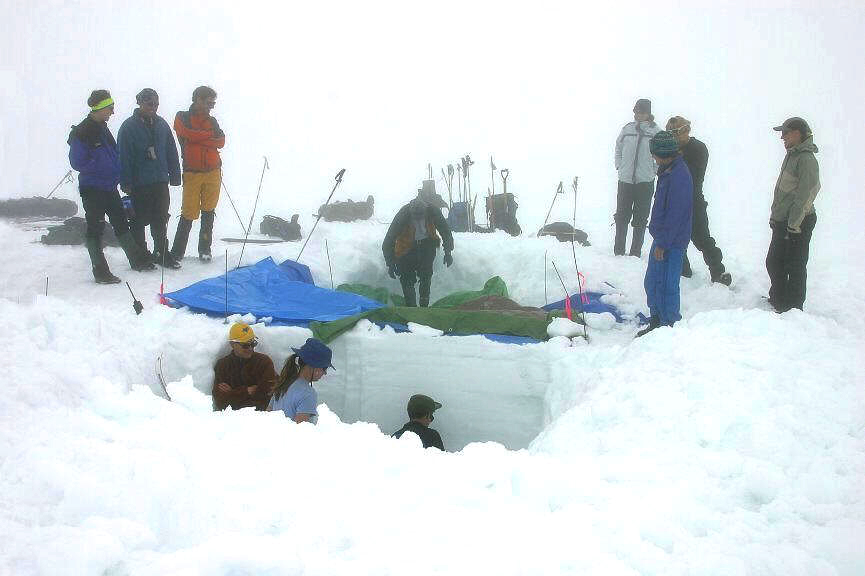Snowpack on:
[Wikipedia]
[Google]
[Amazon]
 Snowpack is an accumulation of
Snowpack is an accumulation of
 Snowpack modeling is done for snow stability, flood forecasting, water resource management, and climate studies. Snowpack modeling is either done by simple, statistical methods such as degree day or complex, physically based energy balance models such as SNOWPACK, CROCUS or SNOWMODEL.
Snowpack modeling is done for snow stability, flood forecasting, water resource management, and climate studies. Snowpack modeling is either done by simple, statistical methods such as degree day or complex, physically based energy balance models such as SNOWPACK, CROCUS or SNOWMODEL.
SNOWPACK
CROCUS
SnowModel
Avalanches Snow
 Snowpack is an accumulation of
Snowpack is an accumulation of snow
Snow consists of individual ice crystals that grow while suspended in the atmosphere—usually within clouds—and then fall, accumulating on the ground where they undergo further changes.
It consists of frozen crystalline water througho ...
that compresses with time and melts seasonally, often at high elevation or high latitude. Snowpacks are an important water resource that feed streams and rivers as they melt, sometimes leading to flooding. Snowpacks provide water to down-slope communities for drinking and agriculture. High-latitude or high-elevation snowpacks contribute mass to glacier
A glacier (; or ) is a persistent body of dense ice, a form of rock, that is constantly moving downhill under its own weight. A glacier forms where the accumulation of snow exceeds its ablation over many years, often centuries. It acquires ...
s in their accumulation zone
On a glacier, the accumulation zone is the area above the firn line, where snowfall accumulates and exceeds the losses from ablation, ( melting, evaporation, and sublimation). The annual equilibrium line separates the accumulation and ablation ...
s, where annual snow deposition exceeds annual melting.
Assessing the formation and stability of snowpacks is important in the study and prediction of avalanche
An avalanche is a rapid flow of snow down a Grade (slope), slope, such as a hill or mountain. Avalanches can be triggered spontaneously, by factors such as increased precipitation or snowpack weakening, or by external means such as humans, othe ...
s. Scientists study the physical properties of snow under different conditions and their evolution, and more specifically snow metamorphism
Metamorphism is the transformation of existing Rock (geology), rock (the protolith) to rock with a different mineral composition or Texture (geology), texture. Metamorphism takes place at temperatures in excess of , and often also at elevated ...
, snow hydrology
Hydrology () is the scientific study of the movement, distribution, and management of water on Earth and other planets, including the water cycle, water resources, and drainage basin sustainability. A practitioner of hydrology is called a hydro ...
(that is, the contribution of snow melt to catchment hydrology), the evolution of snow cover with climate change
Present-day climate change includes both global warming—the ongoing increase in Global surface temperature, global average temperature—and its wider effects on Earth's climate system. Climate variability and change, Climate change in ...
and its effect on the ice–albedo feedback
Ice–albedo feedback is a climate change feedback, where a change in the area of ice caps, glaciers, and sea ice alters the albedo and surface temperature of a planet. Because ice is very reflective, it reflects far more solar energy back to spac ...
and hydrology, both on the ground and by using remote sensing
Remote sensing is the acquisition of information about an physical object, object or phenomenon without making physical contact with the object, in contrast to in situ or on-site observation. The term is applied especially to acquiring inform ...
. Snow is also studied in a more global context of impact on animal habitat
In ecology, habitat refers to the array of resources, biotic factors that are present in an area, such as to support the survival and reproduction of a particular species. A species' habitat can be seen as the physical manifestation of its ...
s and plant succession. An important effort is put into snow classification, both as a hydrometeor and on the ground.
Scientific applications
 Snowpack modeling is done for snow stability, flood forecasting, water resource management, and climate studies. Snowpack modeling is either done by simple, statistical methods such as degree day or complex, physically based energy balance models such as SNOWPACK, CROCUS or SNOWMODEL.
Snowpack modeling is done for snow stability, flood forecasting, water resource management, and climate studies. Snowpack modeling is either done by simple, statistical methods such as degree day or complex, physically based energy balance models such as SNOWPACK, CROCUS or SNOWMODEL.
See also
*Advection
In the fields of physics, engineering, and earth sciences, advection is the transport of a substance or quantity by bulk motion of a fluid. The properties of that substance are carried with it. Generally the majority of the advected substance is a ...
*Glacial period
A glacial period (alternatively glacial or glaciation) is an interval of time (thousands of years) within an ice age that is marked by colder temperatures and glacier advances. Interglacials, on the other hand, are periods of warmer climate betw ...
* Glacier mass balance
*Hydrology
Hydrology () is the scientific study of the movement, distribution, and management of water on Earth and other planets, including the water cycle, water resources, and drainage basin sustainability. A practitioner of hydrology is called a hydro ...
* Subnivean climate
References
{{ReflistExternal links
SNOWPACK
CROCUS
SnowModel
Avalanches Snow